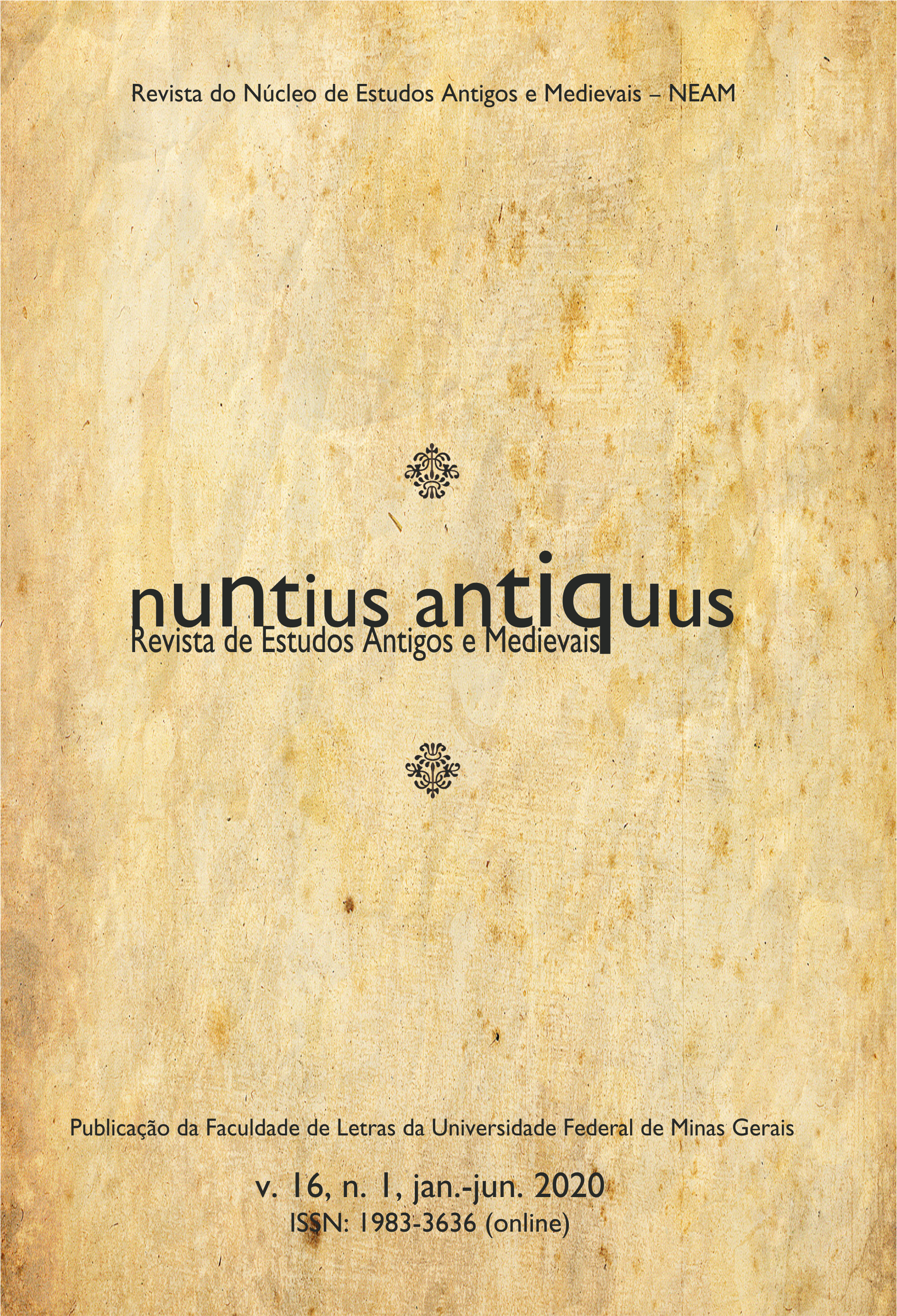The Apsu Saga in Enūma eliš
(Translation and Comments)
Keywords:
Enuma elish, Babylonian cosmogony, Babylonian TheogonyAbstract
This paper presents a translation with comments of the first seventy-eight verses of Enūma eliš, in which, along with the genealogical line that goes from Apsu-Tiámat to Ea, it is reported how the latter overcame the first of the gods.
Downloads
References
BARTASH, Vitali. Puhru: Assembly as a political institution in Enūma eliš (preliminary study). In: KOGAN, L. et al. (ed.). Language in the Ancient Near East. Winona Lake: Eisenbrauns, 2010. p. 1083-1108, v. 1, part 2.
BLACK, Jeremy; GREEN, Anthony. Gods, demons and symbols of Ancient Mesopotamia. Ilustrations by Tessa Rickards. Austin: University of Texas Press, 2003.
BOTTÉRO, Jean. Nascimento de Deus: A Bíblia e o historiador. Tradução de Rosa Freire D’Aguiar. São Paulo: Paz e Terra, 1993.
BOTTÉRO, Jean; KRAMER, Samuel Noah. Lorsque les dieux faisaient l’homme: Mythologie mésopotamienne. Paris: Gallimard, 1993.
BRANDÃO, Jacyntho Lins. Ao Kurnugu, terra sem retorno: Descida de Ishtar ao mundo dos mortos. Curitiba: Kotter, 2019.
BRANDÃO, Jacyntho Lins. Sin-léqi-unninni, Ele que o abismo viu: Epopeia de Gilgámesh. Belo Horizonte: Autêntica, 2017.
CAD: The Assyrian dictionary of the Oriental Institute of the University of Chicago. Chicago: The Oriental Institute/Glückstadt: J. J. Augustin Verlagsbuchlandlung, 1956-2010. 21 volumes.
DAMASCIUS. Traité des premiers principes. Texte établi par Leendert Gerrit Westerink et traduit par Joseph Combès. Paris: Les Belles Lettres, 1991. Vol. 3
DUCHEMIN, Jacqueline. Prométhée: histoire du mythe de ses origines orientales à ses incarnations modernes. Paris: Les Belles Lettres, 2000.
ELLI, Alberto. Enūma eliš: il mito babilonesi della creazione. Testo cuneiforme, traslitterazione, trascrizione, traduzione e commento delle sette travolette. Itália: Mediterraneoantico.it, 2015.
ESPAK, Peeter. Ancient Near Eastern gods Enki and Ea: Diachronical analysis of texts and images from the earliest sources to the Neo-Sumerian period. Tartu: Tartu University, 2006. (tese)
FOSTER, Benjamin R. Epic of creation. In Before the Muses: An anthology of Akkadian literature. Bethesda: CDL Press, 1996. p. 350-401.
GABRIEL, Gösta Ingvar. Enūma eliš – Weg zu einer globalen Weltordnung: Pragmatik, Struktur und Semantik des babylonischen “Lieds auf Marduk”. Tübingen: Mohr Siebeck, 2014.
GEORGE, Andrew R. Cosmogony in ancient Mesopotamia. In: GINDHART, Marion; POMMERENING, Tanja. Aufgang & Ende: vormoderne Szenarien von Weltenstehung und Weltuntergang. Darmstadt: von Zabern, 2016. p. 7-25.
HAUBOLD, Johannes. From text to reading in Enūma eliš. Journal of Cuneiform Studies, v. 69, p. 221-246, 2017. DOI: https://doi.org/10.5615/jcunestud.69.2017.0221.
HEIDEL, Alexander. The Babylonian Genesis: The story of creation. Chicago & London: University of Chicago Press, 1951.
HEIMPEL, Wolfgang. Anthropomorfic and bovine Lahmus. In DIETRICH, M., LORETZ, O. (ed.). Dubsar anta-men: Studien zur Orientalistik (Festschrift für Willem H. Ph. Römer). Münster: Ugarit-Verlag, 1998, p. 129-156.
HOROWITZ, Wayne. Mesopotamian cosmic geography. Winona Lake: Einsenbrauns, 1998.
HOUAISS, Antônio et al. Dicionário Houaiss da língua portuguesa. Rio de Janeiro: Objetiva, 2001.
HUEHNERGARD, John. A grammar of Akkadian. Winona Lake: Eisenbrauns, 2005.
HUTTER, Manfred. ammatu: Unterwelt in Enuma Elis I 2. Revue d’assyriologie et d’archéologie orientale, v. 79, n. 2, p. 187-188, 1985.
JACOBSEN, Thorkild. The treasures of darkness: a History of Mesopotamian religion. New Haven-London: Yale University Press, 1976.
KÄMMERER, T. R.; METZLER, K. A. Das babylonische Weltschöpfungsepos Enūma eliš. Münster: Ugarit-Verlag, 2012.
LAMBERT, Wilfred G. Babylonian creation myths. Winona Lake: Eisenbrauns, 2013.
LAMBERT, Wilfred G. Mesopotamian creation stories. In: GELLER, Markham J., SCHIPPER, Mineke (ed.). Imagining creation. Leiden: Brill, 2008. DOI: https://doi.org/10.1163/ej.9789004157651.i-424.9.
LAMBERT, Wilfred G. Technical terminology for creation in the Ancient Near East. In: PROSECKY, J. (ed.). Intellectual life of the Ancient Near East. Prague: Academy of Sciences of the Czech Republic – Oriental Institute, 1998. p. 189–193.
LAMBERT, Wilfred G. The pair Lahmu-Lahamu in cosmology. Orientalia, nova series, v. 54, n. 1-2, p. 189-202, 1985.
LAMBERT, Wilfred G.; MILLARD, A. R.; CIVIL, M. Atra-hasis: The Babylonian story of the flood, edited by W. G. Lambert and A. R. Millard, with the Sumerian flood story, edited by M. Civil. Winona Lake: Einsenbrauns, 1999.
LÓPEZ-RUIZ, Carolina. How to start a cosmogony: on the poetics of the beginnings in Greece and Near East. Journal of Ancient Near Eastern Religions, v. 12, p. 30-48, 2012. DOI: https://doi.org/10.1163/156921212X629455.
MIEROOP, Mar van de. Philosophy before the Greeks: The pursuit of truth in ancient Babylonia. Princeton: Princeton University Press, 2015. DOI: https://doi.org/10.23943/princeton/9780691157184.001.0001.
MROZEK, Andrej; VOTTO, Silvano. The motif of the sleeping divinity. Biblica, v. 80, p. 415-419, 1999.
OSHIMA, Takayoshi. “Let us sleep!”: The Motif of Disturbing Resting Deities in Cuneiform Texts. In: DIETRICH, Manfried, METZLER, Kai A., NEUMANN, Hans. Studia Mesopotamica: Jahrbuch für altorientalische Geschichte und Kultur. Münster: Ugarit Verlag, 2014. p. 271-289. v. 1.
SONIK, Karen. Gender Matters in Enūma Eliš. In BEAL, Richard H.; HOLLOWAY, Steven W.; SCURLOCK, JoAnn (ed.). In the Wake of Tikva Frymer-Kensky. Piscataway: Gorgias Press, 2009. p. 85-101.
TALON, Philippe. Enūma Eliš and the transmission of Babylonian cosmology to the West. In: WHITING, R. M. (ed.). Mythology and mythologies: Methodological approaches to intercultural influences. Helsinki: Univesity of Helsinki Neo-Assyrian Text Corpus Project, 2001. p. 265-277.
TALON, Philippe. Le premier episode de l’ Enūma eliš. In: BRENT, M., TALON, P. (ed.). L’atelier de l’orfèvre: Mélanges offerts à Philippe Derchain. Leuven: Lettres Orientales, 1992, p. 131-146.
TALON, Philippe. The standard Babylonian Creation Myth Enūma Eliš: Introduction, cuneiform text, transliteration, and sign list with a translation and glossary in French by Philippe Talon. Helsinki: Univesity of Helsinki Neo-Assyrian Text Corpus Project, 2005.
TOORN, Karel van der; BECKING, Bob; HORST, Peter van der. Dictionary of deities and demons in the Bible. Leiden: Brill, 1999.
VOGELZANG, Marianna E. Patterns introducing direct speech in Akkadian literary texts. Journal of Cuneiform Studies, v. 42, n. 1, p. 50-70, 1990. DOI: https://doi.org/10.2307/1359873.
WIGGERMANN, F. A. M. Exit talim! Studies in Babylonian demonology, I. Jaarbericht Ex Oriente Lux, n. 27, p. 90-105, 1981-1982.
XIANG, Zairong. Below either/or: Rereading feminity and monstruosity inside Enūma Eliš. Feminist Theology, v. 26, n. 2, p. 115-132, 2018.
YINGLING, E. Odin. Give me back my idol: Investigating the dating of Enūma Eliš. Studia Antiqua, v. 9, n. 1, p. 33-38, 2011. DOI: https://doi.org/10.1177/0966735017737716.





